|
Mark-8 Minicomputer
Apple-1
MOS Kim-1
V C F
Imsai 8080
Kenbak-1
TV Typewriter
LSI ADM-3A
ASR-33
The Digital Group
My Collection
HP-01
Test Equipment
Model Rocketry
| |
|
|
|
|
|

|
The
original,
unreadable,
digital group
logo. |
|
|
|
|
|
|
|
|
|
|
|
The digital
group TV Typewriter
When the Mark-8 Minicomputer made it's debut on the cover of
Radio Electronics in July of 1974, it drew the attention of an
unusually large number of entrepreneurs. Within just a couple of
months, newsletters had began, and companies started or moved to
supply hobbyist with parts and information in the new field of
personal computing. One of those moving quickly was Dr. Robert
Suding, a founding member of the digital
group. Among the first products designed by Dr. Suding to be
offered by the digital group was a video card, as seen here, part
of my TV Typewriter. This card was not intended as a stand-alone
TV Typewriter so much as it was a direct addition to the Mark-8
itself. In an interview with Dr. Suding, he placed the date of
these video cards in late 1974.
|
|
The video card has a total
of 256 bytes of Intel 1101 memory. When I obtained the video card,
I had little information on it, and I am thankful to all who
emailed me and contributed bits of the puzzle. My card came to me
missing a few chips, and looking a little rough. I managed to
reverse engineer the circuitry and get the card operational just
in time to receive a copy of the digital group "Packet
#1", which fully describes the card, with schematics, and
preceded the introduction of the card by a month or two. The
packet also included other useful circuits and improvements to the
Mark-8. Whoopee!! With the full information in hand, I built the
TV Typewriter as shown here.
|
|

146 KB
|
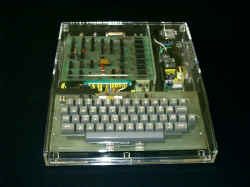
136 KB
|
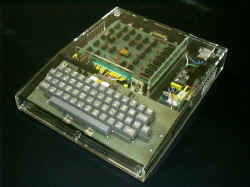
148 KB
|
| Construction
It took me quite a while to decide what to do with my video
card. I did not want to add it directly to my Mark-8, as I wanted
to preserve the Mark-8 in original condition, but did not have any
alternative ideas that seemed acceptable. I also knew that I would
want to use it with my Mark-8 in some way, since it was originally
designed specifically for the Mark-8. After having plastic covers
made for a few of my other machines, I decided to build a cabinet
completely out of plastic. The challenge was to make it attractive
and functional. The keyboard used was a complete unknown, picked
up at surplus for an incredible price of just $2.50, and it is configured and
labeled just like my ASR-33 keyboard, which I thought was a great
bonus. I added lower case capability to the keyboard by a toggle
switch on the rear panel, and the key pressed strobe has a
selectable connection to the Mark-8 interrupt line via another
rear panel toggle. This allows programming to handle keyboard
operations through interrupts, a useful tactic for many
applications.
|
| The power
supply is a modern day switcher chosen for small size and
reliability. A required -9 volt input is supplied by a small
regulator, visible in these photos just above the keyboard near
the video card connector. The cabinet was built from my drawings
by Hawkeye Plastics in Mesa, Arizona. They did a fantastic job.
The monitor shown is a surplus item I picked up years ago. The housing was designed by me and made by Hawkeye plastics.
Operation
The operation of the TVT is a little clumsy and a bit off-beat.
Although the keyboard will encode all of the standard control
characters, the video card does not recognize anything but a
"home" command. This means there is no cursor, no cursor
functions such as a backspace , up or down movement, etc. Worst of
all, no screen erase, carriage return or line feed! All of this
must be implemented in software if it is desired! Otherwise, it
works great!
The screen shows eight lines of thirty-two characters per line.
Quite small, but very usable. It is functional as a stand alone
TVT by use of a jumper plug that fits into the output connector,
looping the keyboard outputs to the video card inputs. It also
plugs directly into my Mark-8 rear connector.
|

143 KB
|
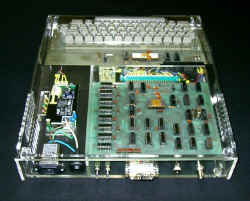
146 KB
|
|

219 KB
|
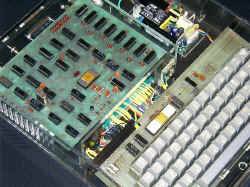
232 KB
|
|
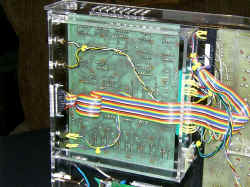
204 KB
|
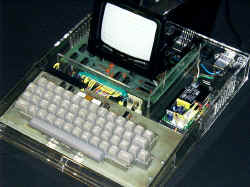
202 KB
|
| The TVT
operates with only one quirk: it is a little slow, and requires a
short delay implemented in software to update the screen without
errors. This may be fixed by finding the slow chip in the memory
bank, but I have no intention of changing any of the original
chips at this time. |
|

Photos of the Digital Group Video card used in the TV
Typewriter
|
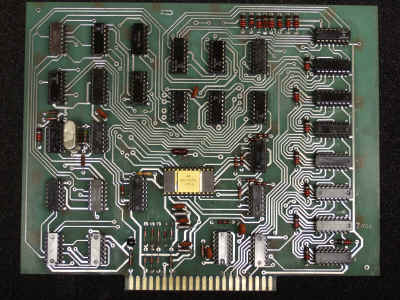 |
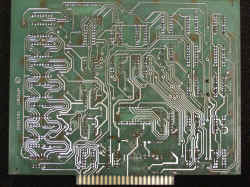
|
 |
|

![]()